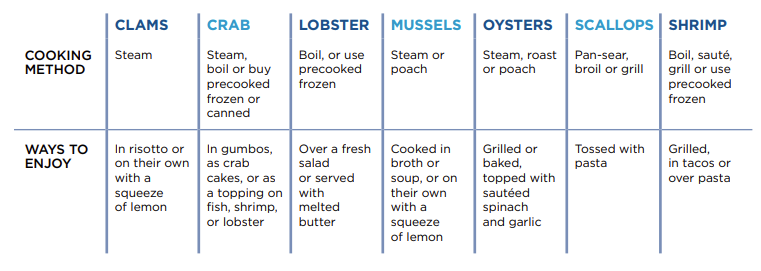The Ultimate Guide to Cooking Seafood
Seafood Nutrition Partnership
February 2, 2023

Take the stress out of planning and preparing family meals with seafood! Our partners at Seafood Nutrition Partnership have some quick tips to make sure your seafood meals turn out delicious every time.
Best Ways to Cook Fish
There are 6 simple techniques for mastering the art of fish cooking at home.
- Broiling: Get that grilled taste without the grill; cook fish in an oven set to broil, skin side up. This method is good for skin-on fillets or small whole fish.
- En Papillote: Enclose seasoned fillets in parchment, gently roast in oven. This method is good for medium to firm fish.
- Grilling: Cook over high heat; brush with oil and cover with herbs and citrus. This method is good for whole fish or skin-on fillets.
- Pan Searing: Score fish skin with a few shallow cuts. Cook skin-side down in pan until crispy, then flip. This method is good for skin-on or skinless fillets.
- Poaching: Gently cook fillets in simmering stock or sauce such as tomato or curry. Submersion is key. This method is good for lean, flaky fish.
- Roasting: Cook thawed or frozen fillets in a 400˚F oven (375˚F for whole fish). This method is good for medium to fatty fish.
When defrosting frozen fish its best to let the fish thaw slowly in the refrigerator overnight on a paper towel. If you’re in a rush, you can place the fish in a water-tight bag and submerge it in cold water for 15-20 minutes.
When determining how long to cook a fish, try the 10-minute rule. Measure the fish at its thickest point and cook it on medium heat for 10 minutes per inch, turning the fish over halfway through the cook time. That means a thin fish like sole or perch cooks in about 4-5 minutes while a thicker salmon or tuna steak might be closer to 15-20 minutes.
Best Ways to Cook Shellfish

How do you know if your shellfish is done? Here are a few rules of thumb:
- Raw shrimp: will turn pink and become firm.
- Live oysters, clams and mussels: shells will open when they are done.
- Shucked oysters, clams and mussels: will become plump and opaque. The edges of the oysters will start to curl.
- Scallops: will turn white or opaque and become firm to the touch.
- Crab and lobster: shells will turn bright red and the meat will become white or opaque.
For more tips on how to cook seafood, check out the Ultimate Guide to Cooking Seafood from the Seafood Nutrition Partnership.
